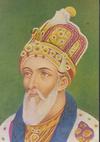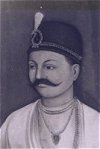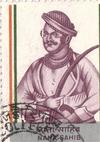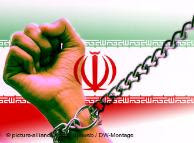ادعا سايت جهان (اصولگرا) :این عکس در جریان حضور هوشنگ امیراحمدی، در شمال کشور گرفته شده است. نفر سمت چپ (كت شلوار تيره) پسر اميراحمدي است .
۱۳۸۹ مرداد ۱۷, یکشنبه
هوشنگ امیراحمدی و پسرش در ایران
«رهبران جامعه بهایىیران هر کدام به ۲۰ سال حبس محکوم شدند»
رادیو فردا: به گفته نماینده جامعه بهایى در سازمان ملل متحد، هفت تن از رهبران جامعه بهایى ایران که از حدود دو سال پیش در زندان به سر مىبرند، هر کدام به ۲۰ سال زندان محکوم شدهاند.
دیان علایى، نماینده جامعه بهاییان در سازمان ملل متحد، روز یکشنبه در گفتوگو با رادیو فردا اعلام کرد، هفت تن از رهبران جامعه بهایى ایران که محاکمه آنها در اواخر خرداد ماه به پایان رسیده بود، هر کدام به ۲۰ سال زندان محکوم شدهاند.
فریبا کمالآبادى، جمالالدین خانجانى، عفیف نعیمى، سعید رضایى، مهوش ثابت، بهروز توکلى و وحید تیزفهم، هفت تن از رهبران جامعه بهایى ایران هستند که از حدود دو سال پیش در زندان به سر مىبرند.
دستگاه قضایى جمهورى اسلامى این هفت نفر را به اتهام «جاسوسى، اقدام علیه امنیت کشور و محاربه» محاکمه کرده است. آخرین جلسات دادگاه رسیدگى به این اتهامها در اواخر خرداد ماه برگزار شد و پس از سه روز به پایان رسیده بود.
در این میان دیان علایى، نماینده جامعه بهایى در سازمان ملل با «ناعادلانه» خواندن حکم صادر شده براى رهبران بهاییان ایران یک بار دیگر تاکید کرده است، این هفت نفر «کاملاً بىگناه» هستند.
وى پیشتر نیز با تاکید بر این که این هفت تن تنها به امور روحانى و ادارى جامعه بهاییان رسیدگى مىکردند و هیچ خلافى مرتکب نشدهاند، گفته بود، دستگیرى و محاکمه آنها نشانه نقض حقوق بشر در مورد بهاییان ایرانى است.
خانم علایى یک بار دیگر با بیان این که این افراد صرفاً به دلیل بهایى بودنشان بازداشت و محاکمه شدهاند، درباره روند حقوقى رسیدگى به اتهامهاى رهبران بهایى ایران گفته است: «روند حقوق اصولاً از ابتدا کاملاً اشتباه بوده است. زیرا این هفت نفر مدتهاى طولانى در سلولهاى انفرادى بودند، بدون این که بدانند جرمشان چیست.»
نماینده جامعه بهاییان در سازمان ملل همچنین با اشاره به این که حتى پس از آن که رهبران بازداشتى بهایى از سلول انفرادى هم خارج شدند، تفهیم اتهام نشده بودند، اعلام کرد، حکم بازداشت موقت این افراد نیز هر دو ماه یک بار تمدید مىشد که این اقدام هم «غیرقانونى» است.
به گفته خانم علایى وکلاى رهبران بازداشت شده جامعه بهاییان ایران در مدت بیش از دو سال بازداشت آنها تنها یک ساعت اجازه ملاقات با موکلان خود را در زندان یافته بودند.
این نماینده جامعه جهانى بهاییان یک بار دیگر با تاکید بر بىگناهى رهبران بهاییان ایران خواستار «آزادى فورى» آنها شده است.
هر چند بر اساس اعلام جامعه بهاییان اروپا، حدود ۳۰۰ هزار نفر از پیروان آیین بهایى در ایران زندگى مىکنند، با این حال مقامهاى جمهورى اسلامى این مذهب را به رسمیت نمىشناسند و محدودیتهاى زیادى براى پیروان آن در نظر گرفتهاند.
Gandhi: A Biography
First Online: August 15,1997
Page Last Updated: June 15,2010
First See: Introduction to learn Who was Gandhi?
Early Years
Mohandas Karamchand Gandhi (1869-1948), also known as Mahatma Gandhi, was born in Porbandar in the present day state of Gujarat in India on October 2, 1869. He was raised in a very conservative family that had affiliations with the ruling family of Kathiawad. He was educated in law at University College, London. In 1891, after having been admitted to the British bar, Gandhi returned to India and attempted to establish a law practice in Bombay, without much success. Two years later an Indian firm with interests in South Africa retained him as legal adviser in its office in Durban. Arriving in Durban, Gandhi found himself treated as a member of an inferior race. He was appalled at the widespread denial of civil liberties and political rights to Indian immigrants to South Africa. He threw himself into the struggle for elementary rights for Indians.
See Also: Parentage and Childhood from Gandhi's autobiography
Resistance to Injustice
Gandhi remained in South Africa for twenty years, suffering imprisonment many times. In 1896, after being attacked and humiliated by white South Africans, Gandhi began to teach a policy of passive resistance to, and non-cooperation with, the South African authorities. Part of the inspiration for this policy came from the Russian writer Leo Tolstoy, whose influence on Gandhi was profound. Gandhi also acknowledged his debt to the teachings of Christ and to the 19th-century American writer Henry David Thoreau, especially to Thoreau's famous essay "Civil Disobedience." Gandhi considered the terms passive resistance and civil disobedience inadequate for his purposes, however, and coined another term, Satyagraha (from Sanskrit, "truth and firmness"). During the Boer War, Gandhi organized an ambulance corps for the British army and commanded a Red Cross unit. After the war he returned to his campaign for Indian rights. In 1910, he founded Tolstoy Farm, near Durban, a cooperative colony for Indians. In 1914 the government of the Union of South Africa made important concessions to Gandhi's demands, including recognition of Indian marriages and abolition of the poll tax for them. His work in South Africa complete, he returned to India.
![]()
Campaign for Home Rule
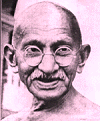 Gandhi became a leader in a complex struggle, the Indian campaign for home rule. Following World War I, in which he played an active part in recruiting campaigns, Gandhi, again advocating Satyagraha, launched his movement of non-violent resistance to Great Britain. When, in 1919, Parliament passed the Rowlatt Acts, giving the Indian colonial authorities emergency powers to deal with so-called revolutionary activities, Satyagraha spread throughout India, gaining millions of followers. A demonstration against the Rowlatt Acts resulted in a massacre of Indians at Amritsar by British soldiers; in 1920, when the British government failed to make amends, Gandhi proclaimed an organized campaign of non-cooperation. Indians in public office resigned, government agencies such as courts of law were boycotted, and Indian children were withdrawn from government schools. Throughout India, streets were blocked by squatting Indians who refused to rise even when beaten by police. Gandhi was arrested, but the British were soon forced to release him.
Gandhi became a leader in a complex struggle, the Indian campaign for home rule. Following World War I, in which he played an active part in recruiting campaigns, Gandhi, again advocating Satyagraha, launched his movement of non-violent resistance to Great Britain. When, in 1919, Parliament passed the Rowlatt Acts, giving the Indian colonial authorities emergency powers to deal with so-called revolutionary activities, Satyagraha spread throughout India, gaining millions of followers. A demonstration against the Rowlatt Acts resulted in a massacre of Indians at Amritsar by British soldiers; in 1920, when the British government failed to make amends, Gandhi proclaimed an organized campaign of non-cooperation. Indians in public office resigned, government agencies such as courts of law were boycotted, and Indian children were withdrawn from government schools. Throughout India, streets were blocked by squatting Indians who refused to rise even when beaten by police. Gandhi was arrested, but the British were soon forced to release him.
Economic independence for India, involving the complete boycott of British goods, was made a corollary of Gandhi's Swaraj (from Sanskrit, "self-governing") movement. The economic aspects of the movement were significant, for the exploitation of Indian villagers by British industrialists had resulted in extreme poverty in the country and the virtual destruction of Indian home industries. As a remedy for such poverty, Gandhi advocated revival of cottage industries; he began to use a spinning wheel as a token of the return to the simple village life he preached, and of the renewal of native Indian industries.
Gandhi became the international symbol of a free India. He lived a spiritual and ascetic life of prayer, fasting, and meditation. His union with his wife became, as he himself stated, that of a brother and sister. Refusing earthly possessions, he wore the loincloth and shawl of the lowliest Indian and subsisted on vegetables, fruit juices, and goat's milk. Indians revered him as a saint and began to call him Mahatma (great-souled), a title reserved for the greatest sages. Gandhi's advocacy of nonviolence, known as ahimsa (non-violence), was the expression of a way of life implicit in the Hindu religion. By the Indian practice of nonviolence, Gandhi held, Great Britain too would eventually consider violence useless and would leave India.
The Mahatma's political and spiritual hold on India was so great that the British authorities dared not interfere with him. In 1921 the Indian National Congress, the group that spearheaded the movement for nationhood, gave Gandhi complete executive authority, with the right of naming his own successor. The Indian population, however, could not fully comprehend the unworldly ahimsa. A series of armed revolts against the British broke out, culminating in such violence that Gandhi confessed the failure of the civil-disobedience campaign he had called, and ended it. The British government again seized and imprisoned him in 1922.
After his release from prison in 1924, Gandhi withdrew from active politics and devoted himself to propagating communal unity. Unavoidably, however, he was again drawn into the vortex of the struggle for independence. In 1930 the Mahatma proclaimed a new campaign of civil disobedience, calling upon the Indian population to refuse to pay taxes, particularly the tax on salt. The campaign was a march to the sea, in which thousands of Indians followed Gandhi from Ahmedabad to the Arabian Sea, where they made salt by evaporating sea water. Once more the Indian leader was arrested, but he was released in 1931, halting the campaign after the British made concessions to his demands. In the same year Gandhi represented the Indian National Congress at a conference in London.
Kamat's Potpourri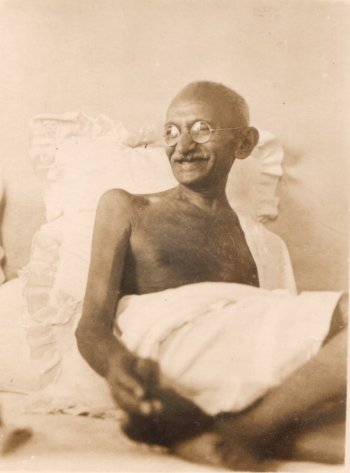
Smiling Gandhi
Photograph by V.N. O'key, circa 1945
Gandhi takes on Domestic Problems
In 1932, Gandhi began new civil-disobedience campaigns against the British. Arrested twice, the Mahatma fasted for long periods several times; these fasts were effective measures against the British, because revolution might well have broken out in India if he had died. In September 1932, while in jail, Gandhi undertook a "fast unto death" to improve the status of the Hindu Untouchables. The British, by permitting the Untouchables to be considered as a separate part of the Indian electorate, were, according to Gandhi, countenancing an injustice. Although he was himself a member of an upper caste, Gandhi was the great leader of the movement in India dedicated to eradicating the unjust social and economic aspects of the caste system.
In 1934 Gandhi formally resigned from politics, being replaced as leader of the Congress party by Jawaharlal Nehru. Gandhi traveled through India, teaching ahimsa and demanding eradication of "untouchability." The esteem in which he was held was the measure of his political power. So great was this power that the limited home rule granted by the British in 1935 could not be implemented until Gandhi approved it. A few years later, in 1939, he again returned to active political life because of the pending federation of Indian principalities with the rest of India. His first act was a fast, designed to force the ruler of the state of Rajkot to modify his autocratic rule. Public unrest caused by the fast was so great that the colonial government intervened; the demands were granted. The Mahatma again became the most important political figure in India.
© K. L. Kamat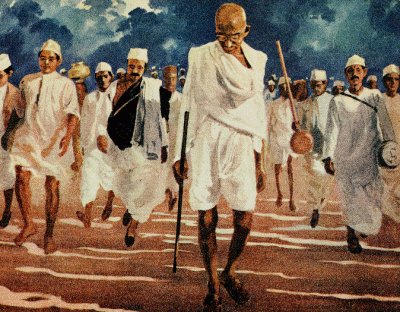
Man of Firm Step
![]()
Independence for India
Kamat's Potpourri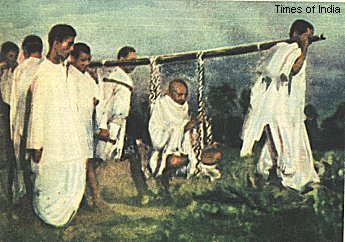
Men Carrying Gandhi, Noakhali
By 1944 the Indian struggle for independence was in its final stages, the British government having agreed to independence on condition that the two contending nationalist groups, the Muslim League and the Congress party, should resolve their differences. Gandhi stood steadfastly against the partition of India but ultimately had to agree, in the hope that internal peace would be achieved after the Muslim demand for separation had been satisfied. India and Pakistan became separate states when the British granted India its independence in 1947 (see: Tryst with Destiny -- the story of India's independence). During the riots that followed the partition of India, Gandhi pleaded with Hindus and Muslims to live together peacefully. Riots engulfed Calcutta, one of the largest cities in India, and the Mahatma fasted until disturbances ceased. On January 13, 1948, he undertook another successful fast in New Delhi to bring about peace, but on January 30, 12 days after the termination of that fast, as he was on his way to his evening prayer meeting, he was assassinated by a fanatic Hindu.
See Also:
- Sardar Bhagat Singh
- Bal Gangadhar Tilak
- Indian War of Independence
- Gandhiji and his views on Women
- India's Struggle for Freedom
![]()
First Online: January 08,1998
Page Last Updated: June 15,2010
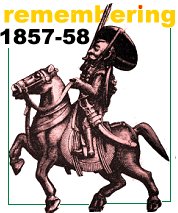 India's First War of Independence, termed Sepoy Riots by the British was an attempt to unite India against the invading British and to restore power to the Mogul emperor Bahadur Shah. The resistance disintegrated primarily due to lack of leadership and unity on the part of Indians, as also to cruel suppression by the British Army. It was a remarkable event in Indian history and marked the end of the Mogul empire and sealed India's fate as a British colony for the next hundred years.
India's First War of Independence, termed Sepoy Riots by the British was an attempt to unite India against the invading British and to restore power to the Mogul emperor Bahadur Shah. The resistance disintegrated primarily due to lack of leadership and unity on the part of Indians, as also to cruel suppression by the British Army. It was a remarkable event in Indian history and marked the end of the Mogul empire and sealed India's fate as a British colony for the next hundred years.
Conditions
Indians working for the British Army, due to their deep traditions and faith faced numerous social barriers. In 1856 it was rumored that additional troops were to be recruited for service in Burma, where they could not follow all their religious rules, and that Christian missionary efforts among the troops were to receive official encouragement. The Zamindars (land owners) of the time wanted to protect their interests in the wake of land reforms by the British and funded anti-English activities.
The insurrection was triggered when the British introduced new rifle cartridges rumored to be greased with oil made from the fat of animals. The fat of cows was taboo to Hindus (see: Holy Cows) while Muslims were repelled by pig fat.
Violence
The violence started on May 10, 1857 in Meerut, when Mangal Pandey, a soldier in the Army shot his commander for forcing the Indian troops to use the controversial rifles. Indians constituted 96% of the 300,000 British Army and the violence against British quickly spread (hence the name Sepoy Mutiny). The local chiefs encouraged scattered revolts in hopes of regaining their lost privileges.Siege of Delhi
Bahadur Shah II, by now the pensioned descendant of the Mogul dynasty, was popularly acclaimed as the leader of resistance. On June 8 a British relief force defeated an army of mutineers at Badli Sari and took up a position on the famous ridge, overlooking the city of Delhi. Nominally the besieging force, they were themselves besieged by the mutineers, who made a daring attempt to intercept their train. The arrival of more British reinforcements finally led to the defeat of the mutineers by John Nicholson, commander of the relief force. After six days of street fighting, Delhi was recaptured. This action was the turning point in the campaign and is known as Siege of Delhi. Bahadur Shah was captured and was exiled to Burma.Corbis-Bettmann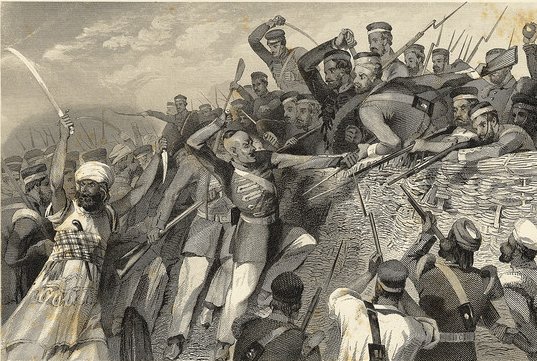
The Attack of Mutineers, July 30, 1857
"One of their leaders waving his sword, shouted 'Come on my braves!"
Illustration from London Printing Company Limited
British Take Control
In spite of the loyalty of the Sikh troops, conquered only eight years before, and of the Gurkhas, the British commander, Sir Colin Campbell, had a difficult task. In addition to quelling the disturbance, he also had to protect the Ganges Valley and all of Hindustan against possible attacks from central India, to the south. Forces were dispatched from Madras and Bombay. However, the revolt had quickly spread to Kanpur and Lucknow. Kanpur, a city controlled by British on the Ganges 250 miles southeast of Delhi, surrendered to the Indian soldiers on June 28, 1857, and was the scene of a massacre before it was recaptured by the British on July 16. Lucknow, forty-five miles to the northeast, had been immediately besieged by the mutineers and was relieved by Henry Havelock's troops on September 25, five days after the final reoccupation of Delhi, the other chief center of the mutiny. However, Havelock's forces, even when joined by those of James Outram, were not strong enough to disarm and remove the enemy garrison, and they had to be relieved on November 16 by troops under Colin Campbell. The civilians of Lucknow were evacuated, but not until the siege of Mar. 9-16, 1858, had enough British troops massed to defeat the rebel army.
Kamat's Potpourri
Indian Soldiers Being Executed by British Canons
The aftermath of India's First War of Independence, 1858
The final stage of the mutiny took place in central India, which was aroused by a roving band of rebels under the Maratha General Tatya Tope. After his capture and execution in April 1859, the leaderless Indians were soon pacified.
|
|
|
Why the Rebels Failed
-
Many native Indian states, influenced by the example of powerful Hyderabad, did not join the rebels.
-
Sikh soldiers of the Punjab area remained loyal to the British throughout. The Sikhs were a strong, well trained army, who the British had conquered using Indian soldiers.
-
The aging Bahadur Shah was neither a brave general, nor an astute leader of the people
Epilogue
In England, the mutiny proved the last straw on the heavy load of criticism and opposition which the East India Company had carried for some time. In August 1858, by the Act for the Better Government of India, its political authority was entrusted to a secretary of state. In August 1858 the British crown assumed control of India from the East India Company and in 1877 Queen Victoria was crowned as the Empress of India. The mutiny played a pivotal role in Anglo-Indian history. The British afterward became cautious and defensive about their empire, while many Indians remained bitter and would never trust their rulers again.
It was not until the emergence of Indian National Congress and Mahatma Gandhi that Indians re-gathered their momentum for home rule.
![]()
See Also
- History Potpourri -- Social and political history of India; includes history of freedom struggle, history of drinking, history of education, dynasties, and religious movements
- Biographies of Gandhi, Bose, Singh, Cama
- Tryst with Destiny

- 1858 Lithograph

- Queen of Jhansi Lakshmibai
- Important Leaders of Sepoy Mutiny
Queen Lakshmibai of Jhansi
by Dr. Jyotsna Kamat
First Online: July 13,2007
Last Updated: June 15,2010
Rani Lakshmibai of Jhansi (1835 � 1858)
It is appropriate to remember the young brave queen of Jhansi on the occasion of 150th year of First War of Independence which is also called "Sepoy Mutiny". When we learn about courage and fearless fighting of Lakshmibai who died fighting the British on the battlefield, it was not a mere �mutiny�. It was an honest attempt to resist misrule and injustice of the British, who were bent on expanding their colonial interests in India, by harming the native rules and the ruled alike.
Lakshmibai was born at Banaras of Moropant Tembe and Bhagirathibai. She was married to Gangadhar Rao Navalkar, the ruler of Jhansi, a small state created by the Peshwas. Moropant was a prot�g� of Peshwa Baji Rao II and accompanied him even after the Peshwa lost his kingdom. A liberal father, he had provided, proper education & martial training to his daughter. Gangadhar Rao died in 1853 CE without Issue. Lakshmibai was not allowed to adopt a successor by the Governor General. The idea was to annex such regions of childless rulers to British Empire, under their infamous `Doctrine of Lapse'.
The young queen engaged a British Lawyer John Lang for appeal to the Directors of The East India Company in England, (who ruled India on behalf of the British Queen) against the decision.
The appeal failed and Jhansi was annexed to British administration. The Queen was given a humiliating monthly pension of five thousand rupees, which was too small even to maintain her small band of followers. The British thought that in all probability she may leave Jhansi and go to her father's shelter. But the courageous queen decided not to leave her domain at any cost, and got ready to face the consequences.
The rebellion against British by the sepoys broke out at Meerut and Delhi on the 10th of May 1857. Gradually it spread to other parts of northern India. Jhansi claimed authority of the queen Lakshmibai on 9th of June. From that date till the 4th of April 1858, Lakshmibai defended her fort against Sir Hugh Rose. But realizing that her position was becoming weak by hours, she made a adventurous escape from Jhansi fort through the cordon of British troops, on horseback and went to Kalpi and joined the indomitable Tantia Topi (a.k.a Tatia Topi) who had taken on the British relentlessly. They together started recruiting soldiers from Oudh and Doab. The Rajputs and Brahmins, comprised infantry; Rohillas and Muslims formed cavalry. The Queen personally lead the newly formed battalion. She used to dress in military uniform of crimson jacket, crimson trousers and a white turban. It was impossible to tell her gender.
Kamat's Potpourri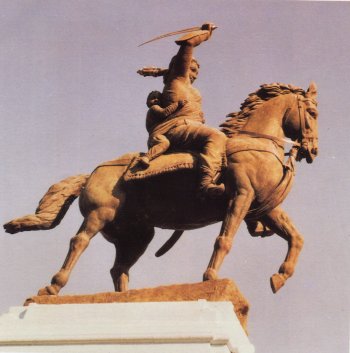
Sculpture of Rani Lakshmibai of Jhansi
Queen But General Rose captured Kalpi, from which Lakshmibai's troops were fighting the British. The and Tantia Topi fled to the jungle. General Rose thinking that the rebellion was over, left and issued orders to disband his troops.
At this juncture, the Rani and Tantia Topi astounded the British by capturing the fort of Gwalior which had good store of arms and ammunition on the 4th of June 1858. It was the hottest part of summer season. The ruler of Gwalior fled and all his troops joined the Rani of Jhansi! Now the rebel army had a equipped contingent, well trained in the British way of warfare.
The ruler of Gwalior was prot�g� of the British and General Rose, reached Morar on the border of Gwalior. Stores and ammunitions were seized with the help of his huge army, on 16th of June. Next day, General Rose crossed Gwalior and met Rani's cavalry, which she was personally leading. The old fashioned muzzle-loaders and clumsy swords of Lakshmibai's troops were no match against well-equipped British army. In the battle that ensued, the Rani fought bravely but was killed. Thus died the young and brave queen far away from her beloved Jhansi overpowered by a superior force.
Rani Lakshmibai is described as a very pretty lady with round face, very delicately shaped nose and bright eyes. She was of medium height and neither stout nor lean. Her portrait with sword and shield shows a determined and pensive expression.
The Bravery of Lakshmibai in Indian Art
The bravery of Lakshmibai has inspired many ballads, legends, paintings and sculptures. Here's a collection of pictures from Kamat Picture Archive
Kamat's Potpourri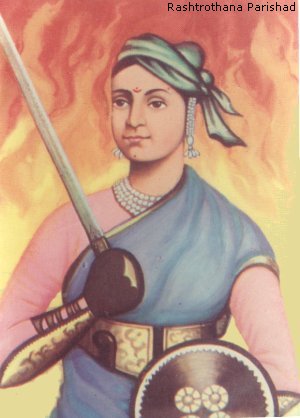
Laxmibai, the Queen of Jhansi
Indian Queen dressed for battle to defend her kingdom against the British
Kamat's Potpourri
Queen of Jhansi, Laxmibai
Painting by Rudrakumar Jha
Kamat's Potpourri
Indian Stamp Honoring Laxmibai of Jhansi
Detail from a Indian postal stamp
Kamat's Potpourri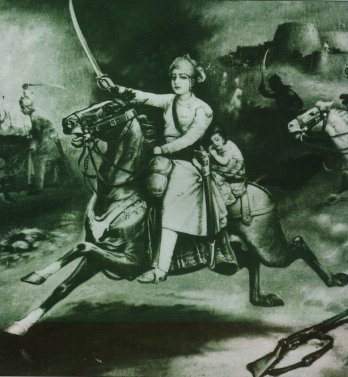
Queen of Jhansi at Battlefield
Kamat's Potpourri
Queen of Jhansi by Mahadev Vishvanath Dhurandhar, 1927
(Picture Courtesy: Annette Biggs)
